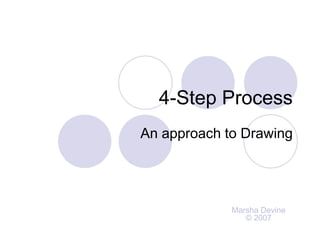
4 Step Drawing Process
- 1. 4-Step Process An approach to Drawing Marsha Devine © 2007
- 2. 4 Step Drawing Process Stick Still Life Sets up structure for drawing / composition Skeleton – no details Quick line strokes Geometric Shapes & Platonic forms Compare shapes in relation to other objects Angles Size Position Positive/negative spaces Big Lights / Big Darks Block out deepest darks and brightest lights Details & Softened Lights/Darks Full range of tones from black to white (having at least 7 steps from black to white gives depth to the drawing) Details & features to refine drawing
- 3. Step 1 Step 1 - The “Stick Still Life” This is the first step of the drawing process. The “Stick Still Life” describes the relative positions, direction, and proportions of the subject matter. It sets up the essential structure and balance of your drawing. Spending time training your eye to create a basic structure for every drawing you make, will greatly enhance your ability. In this step, you are composing your drawing, deciding what elements will be shown, your point of view, and the relationships of the objects to one another. •light quick line strokes •indicate the position and size of each object, •indicate the surface the objects are laying on, •indicate the background
- 4. Step 2 Step 2 - Geometric Shapes and Platonic Form This will be the next step in describing each part of the still life. Take a close look at each element in your still life and lightly sketch in its closest geometric shape. Observe angles, size and position of the shapes in relation to one another. Use the sighting technique described in Drawing on the Right Side of the Brain pp.146 – 152 to measure and sketch in proportions and angles of the objects. •Angles, size, position •Relationships •Sighting tools
- 5. Step 3 Step 3 - Big Lights/Big Darks Next, you will indicate the large dark and light areas of the drawing, including the background and surface it is sitting on. You are looking for BIG shapes of dark and light. The objects do not need to be recognizable at this point. If using pencil, use your soft 6B or 8B pencils to lightly shade in the dark areas. Use 2B or 4B to add some shading for the medium dark areas, and leave the highlights the white of the paper. If using charcoal, add charcoal to the shadow areas to darken them. Use your kneaded eraser or chamois to erase the highlight areas. The middle tone areas will remain the medium gray of the paper. •Block in Big lights, Big darks •Use variety of pencil grades (B, HB, H) and charcoal •Erase highlights
- 6. Step 4 Step 4 - Details, Softened Lights/Darks This is the final step of your drawing. You can now add the details and features unique to your subject matter. Now you soften the lights and darks and go in for as much detail as you like. It is the point where you put the leaves on the trees, features on the face, or highlights on the still-life. •Use a full range of value/tone •Use seven or eight shades of gray from darkest black to lightest white. •You may use compressed charcoal or conte for the darkest areas, and a white pastel or white charcoal pencil for the lightest areas. •If using pencil, add cross contour lines to delineate light and shadow. •Observe carefully and draw the true contours of each shape. •Draw more detail in the objects you wish to emphasize, and less detail on the less important elements. •Know when to stop. (this takes practice!)
- 7. Timing & Practice Timing: An experienced artist can go through steps 1-3 in as little time as 30 seconds- 2 minutes. That is a completed "gesture" drawing or quick sketch which has all the essential components of the drawing ready for final rendering. Your long- term goal is to train your hand/eye to speed up to see these elements quickly in order to go through these steps simultaneously.. However, in the beginning, it is important to go through the process step-by-step Therefore, take between 1 – 3 minutes for each of the first three steps. Step 4 should take considerably longer. Depending on the desired level of detail, it might take 30 minutes to hours, days or even months!!
- 8. Overview 4 Step Drawing Process •Stick Still Life Sets up structure for drawing / composition Skeleton – no details Quick line strokes •Geometric Shapes & Platonic forms Compare shapes in relation to other objects Angles Size Position Positive/negative spaces •Big Lights / Big Darks Block out deepest darks and brightest lights •Details & Softened Lights/Darks Full range of tones from black to white (at least 7 steps from black to white gives depth to the drawing) Details & features to refine drawing
- 9. Basic Forms When you look at an object, no matter how complicated it may seem, the first step is to reduce it to its basic shape. Once this "seeing" of the shape is established, you will be able to draw the object correctly. Basic shapes, forms or "models" are cubes, cylinders, spheres, hexagons, cones, hemispheres, and pyramids.
- 10. Basic Shapes of the Figure http://www.artcluster.com/whiteboard/tips/tip5.html
- 11. Work in progress This is a drawing in progress of the hallway in an Art wing of our local Community College. Approx. 12” x 16” Note the range of values used to add dimension and form.
- 12. Other Resources From Start to Finish, “Crow’s Trick” http://delusionstudio.com/ref/crow/index.html Duey’s Drawings, Tutorial for Still Life http://www.dueysdrawings.com/still_life_tutorial.html
